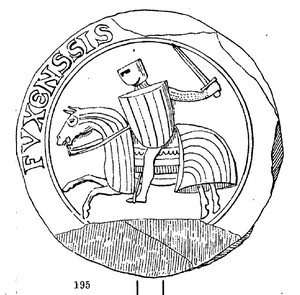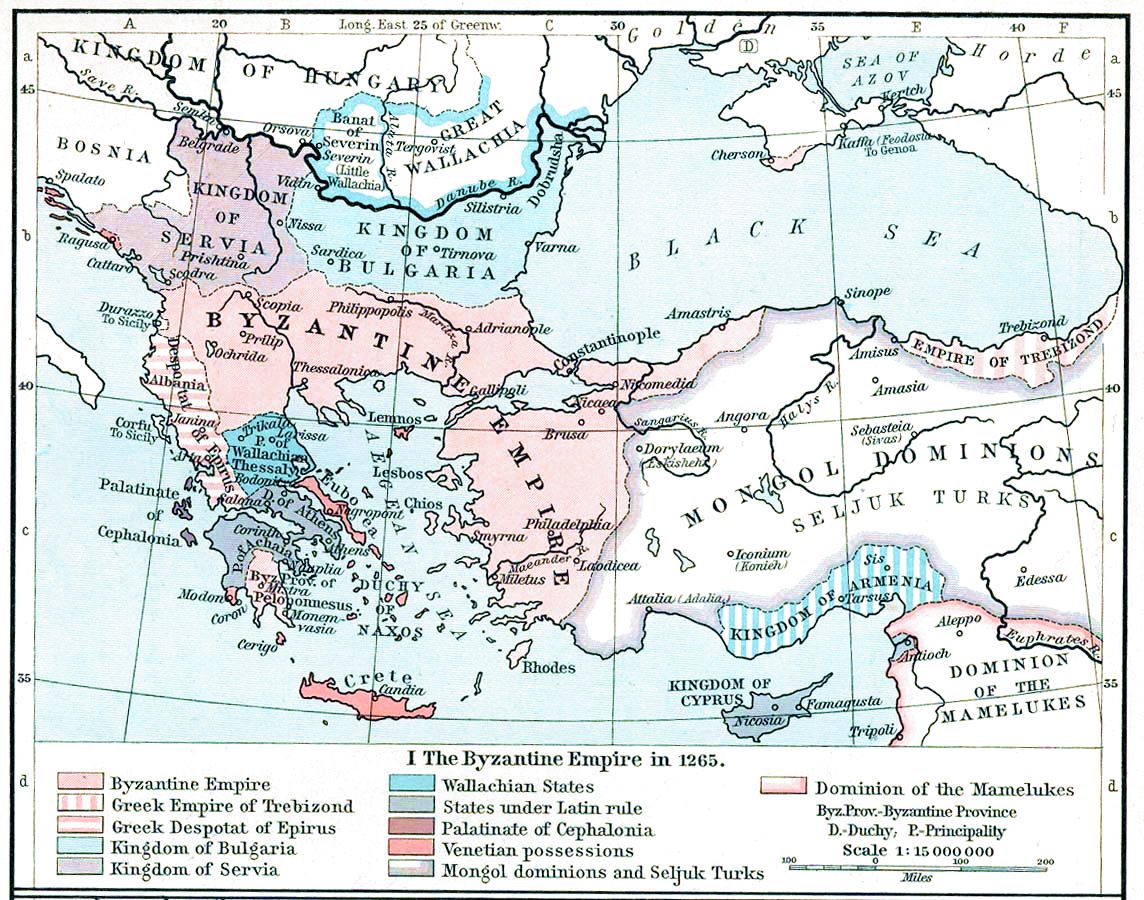|
Roger IV Of Foix
Roger IV (died 24 February 1265), son and successor of Roger-Bernard II the Great, was the eighth count of Foix from 1241 to his death. His mother was Ermessenda de Castellbò. His reign began with the south again at war with the north in France and, though he was reluctant to join his father's old ally, Raymond VII of Toulouse, in revolt and he did not aid the king of England, Henry III, in his Saintonge War. Roger IV was a vassal of both the count of Toulouse (for his county of Foix) and the king of France (for his Carcassonne lands), then Louis IX. His loyalty to the king, however, took precedence and war broke out with Raymond VII (October 1242). Although Raymond was forced to submit to the king on 30 November, the war with Roger continued until January 1243, when the king ended it. The count of Foix was now solely a vassal of the king and Raymond spent the rest of his life (until 1249) trying to retrieve Roger's homage, to no avail. Like his father, Roger IV had trouble ... [...More Info...] [...Related Items...] OR: [Wikipedia] [Google] [Baidu] |
Roger-Bernard II Of Foix
Roger Bernard II (c. 1195 – 26 May 1241), called the Great, was the seventh count of Foix from 1223 until his death. He was the son and successor of the count Raymond-Roger and his wife Philippa of Montcada. Life In 1208, Roger-Bernard married Ermesinde, daughter and heir of Arnau de Castellbò, viscountess of Castellbò and a Cathar. By his wife, he had a son, Roger IV of Foix, and a daughter, Cecilia of Foix. Cecilia of Foix married Álvaro, Count of Urgell. When his relations with his French sovereign allowed it, he concentrated on expansion and fortification southwards. He fortified the towns guarding the way to Andorra and Urgel, and fell into conflict with the bishop of Urgel over the valley of Caboet in May 1233. He opposed the Inquisition and got into even more conflict with the bishop in April 1239. He did not involve himself in the war of Raymond Trencavel, though he did negotiate an honourable treaty in 1240. Albigensian crusade He made his name famous i ... [...More Info...] [...Related Items...] OR: [Wikipedia] [Google] [Baidu] |
1265 Deaths
Year 1265 ( MCCLXV) was a common year starting on Thursday of the Julian calendar. Events By place Europe * January 20 – In Westminster, the first elected English parliament (called Montfort's Parliament) conducts its first meeting in the Palace of Westminster, later to be known as the Houses of Parliament. * March – End of the Hungarian Civil War (1264–1265) – Battle of Isaszeg: Younger King Stephen decisively defeats his father's army. * May 28 – Future King Edward I of England escapes the captivity of Simon de Montfort, 6th Earl of Leicester. * June 18 – A draft Byzantine–Venetian treaty is concluded between Venetian envoys and Emperor Michael VIII Palaiologos, but is not ratified by Doge Reniero Zeno * August 4 – Second Barons' War in England: The Battle of Evesham is fought in Worcestershire, with the army of Edward defeating the forces of rebellious barons led by Simon de Montfort, resulting in the death of Montfort and many of his allies. ... [...More Info...] [...Related Items...] OR: [Wikipedia] [Google] [Baidu] |
Count Of Foix
The Count of Foix ruled the County of Foix, in what is now Southern France, during the Middle Ages. The House of Foix eventually extended its power across the Pyrenees mountain range, joining the House of Bearn and moving their court to Pau in Béarn. Count Francis Phoebus became King of Navarre in 1479. The last count was King Henry III of Navarre, after whose accession to the French throne the county entered the French royal domain. To this day, the president of France is considered an unofficial successor of the count (as the current ruler of the French state) as co-prince of Andorra. Gallery of Arms File:Arms of the Counts of Foix.svg File:Arms of Foix-Béarn.svg, Arms of the House of Foix-Béarn File:Arms of Foix-Grailly.svg, Arms of the House of Foix-Grailly File:Royal Lesser Arms of Navarre (1479-1483).svg, Arms of the House of Foix-Grailly-Navarre File:Royal Arms of Navarre (1483-1512).svg, Arms of the House of Albret File:Arms of Henri de Bourbon.svg, Arms of the Ho ... [...More Info...] [...Related Items...] OR: [Wikipedia] [Google] [Baidu] |
James II Of Majorca
James II () (31 May 1243 – 29 May 1311) was King of Majorca and Lord of Montpellier from 1276 until his death. He was the second son of James I of Aragon and his wife, Violant, daughter of Andrew II of Hungary. In 1279, by the Treaty of Perpignan, he became a vassal of the Crown of Aragon. Biography James inherited from his father a realm including three of the Balearic Islands (Majorca, Ibiza, and Formentera), the counties of Roussillon and Cerdanya, the dominion of Montpellier, the barony of Aumelàs, and the viscounty of Carladès. He also gained tribute from the fourth Balearic island, Menorca, which remained under Muslim control throughout his life. He ruled as a vassal of his brother Peter III of Aragon, a subordinate status which he sought to escape. In 1276, his former seneschal, Ramon Llull persuaded James to fund a language school for Franciscan missionaries at Miramar. France and Aragon contested for control of Sicily. James held rights over borderlands that ... [...More Info...] [...Related Items...] OR: [Wikipedia] [Google] [Baidu] |
Esclaramunda Of Foix
Esclaramunda of Foix (1250–1315) was Queen consort of Majorca from 1276-1311. Life She was the daughter of Roger IV of Foix and Brunisenda of Cardona, daughter of Ramon VIII, Viscount of Cardona. Named after her great-grandmother, Esclaramunda was twenty years old when she married James II of Majorca. As the royal palace or castle was under construction, the new couple moved to Montpellier, but in July 1276 embarked for Majorca. She was responsible for tutoring her grandson James III of Majorca. She was protector of the Order of Mercy. Her feast is on 22 October. Marriage and issue In 1275, Esclaramunda married James II of Majorca, with whom she had six children: * James, who became a Franciscan friar before his father's death. * Sancho, James II's successor * Sancha of Majorca, who married Robert of Naples. * Ferdinand, father of James III * Philip, regent of Majorca during James III's minority * Elizabeth, wife of Juan Manuel, Prince of Villena. She survived her ... [...More Info...] [...Related Items...] OR: [Wikipedia] [Google] [Baidu] |
Aimery IV, Viscount Of Narbonne
Aimeric or Aymeric or Aimery (from ''Haimirich'' or ''Amalric'') is a male given name. Notable people with the name include: * Aimeric de Belenoi (), Gascon troubadour * Prince Aymeric of Belgium (born 2005) * Aymeric Jaubert de Barrault (died 1613), mayor of Bordeaux * Aymeric Jett Montaz (born 2004), French-Canadian actor * Aymeric Laporte (born 1994), French footballer who plays for Manchester City F.C. and the Spain national team * Aimery of Limoges (died c.1196), Latin Patriarch of Antioch * Aimerico Manrique de Lara, Aimeric or Aymeric, sometimes Gallicised as Aimery (1152–1177), ruler of Narbonne * Aymeri de Narbonne, legendary hero of France * Aimery II of Narbonne (died 1134), Viscount of Narbonne * Aimery III of Narbonne (died 1239), known in Spanish as Aimerico Pérez de Lara, Viscount of Narbonne * Aimery IV of Narbonne (Amerigo di Narbona) (c.1230 – 1298), Viscount of Narbonne, Italian condottiero * Ademar de Peiteus (Aimeric de Peiteus), ruler of Diois until 123 ... [...More Info...] [...Related Items...] OR: [Wikipedia] [Google] [Baidu] |
Roger-Bernard III Of Foix
Roger-Bernard III (1243 – 3 March 1302) was the Count of Foix from 1265 to his death. He was the son of Roger IV of Foix and Brunissende of Cardona. He entered into conflicts with both Philip III of France and Peter III of Aragon, who held him in captivity for a time. He was nevertheless a distinguished poet and troubadour. Conflict with Philip III His conflict with Philip III was rooted in the longstanding desire of the French monarchy to establish its authority in Languedoc, where, since the 10th century, it had been practically a dead letter. In 1272, Roger-Bernard allied with Gerald VI, Count of Armagnac to attack the lord of Sompuy, who, however, applied for protection to the king. This brought the king and the count into direct opposition. Ignoring the royal command, the two counts went to war. Philip, claiming rights as the heir of his uncle Alfonso of Poitou, invaded Languedoc at the head of a large army. Roger-Bernard fled to his castle at Foix and the Seneschal ... [...More Info...] [...Related Items...] OR: [Wikipedia] [Google] [Baidu] |
Cardona, Spain
Cardona () is a town in the Spanish region of Catalonia, in the province of Barcelona; about northwest of the city of Barcelona, on a hill almost surrounded by the river Cardener, a branch of the Llobregat. To the east of the town, the river has been diverted through a tunnel has been dug through a spur, leaving a loop of dry river bed near the saltmine. Near the town is an extensive deposit of rock salt. The salt forms a mountain mass (called ''Muntanya de Sal'') covered by a thick bed of a reddish-brown clay, and apparently resting on a yellowish-grey sandstone. It is generally more or less translucent, and large masses of it are quite transparent. The hill has been worked like a mine since Roman times; pieces cut from it have been carved by artists in Cardona into images, crucifixes and many articles of an ornamental kind. Main sights *The Castle of Cardona, which is set high on a hill and contains a Paradores, Parador hotel. *The 11th-century Romanesque architecture, Romanes ... [...More Info...] [...Related Items...] OR: [Wikipedia] [Google] [Baidu] |



